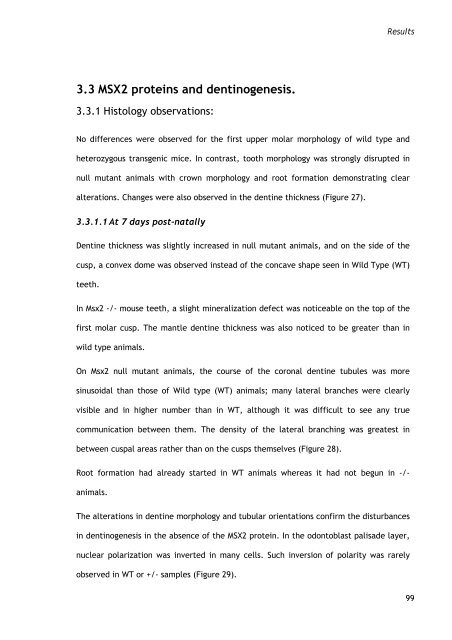Molecular characterisation of odontoblast during primary, secondary ...
Molecular characterisation of odontoblast during primary, secondary ...
Molecular characterisation of odontoblast during primary, secondary ...
You also want an ePaper? Increase the reach of your titles
YUMPU automatically turns print PDFs into web optimized ePapers that Google loves.
3.3 MSX2 proteins and dentinogenesis.<br />
3.3.1 Histology observations:<br />
Results<br />
No differences were observed for the first upper molar morphology <strong>of</strong> wild type and<br />
heterozygous transgenic mice. In contrast, tooth morphology was strongly disrupted in<br />
null mutant animals with crown morphology and root formation demonstrating clear<br />
alterations. Changes were also observed in the dentine thickness (Figure 27).<br />
3.3.1.1 At 7 days post-natally<br />
Dentine thickness was slightly increased in null mutant animals, and on the side <strong>of</strong> the<br />
cusp, a convex dome was observed instead <strong>of</strong> the concave shape seen in Wild Type (WT)<br />
teeth.<br />
In Msx2 -/- mouse teeth, a slight mineralization defect was noticeable on the top <strong>of</strong> the<br />
first molar cusp. The mantle dentine thickness was also noticed to be greater than in<br />
wild type animals.<br />
On Msx2 null mutant animals, the course <strong>of</strong> the coronal dentine tubules was more<br />
sinusoidal than those <strong>of</strong> Wild type (WT) animals; many lateral branches were clearly<br />
visible and in higher number than in WT, although it was difficult to see any true<br />
communication between them. The density <strong>of</strong> the lateral branching was greatest in<br />
between cuspal areas rather than on the cusps themselves (Figure 28).<br />
Root formation had already started in WT animals whereas it had not begun in -/-<br />
animals.<br />
The alterations in dentine morphology and tubular orientations confirm the disturbances<br />
in dentinogenesis in the absence <strong>of</strong> the MSX2 protein. In the <strong>odontoblast</strong> palisade layer,<br />
nuclear polarization was inverted in many cells. Such inversion <strong>of</strong> polarity was rarely<br />
observed in WT or +/- samples (Figure 29).<br />
99
















